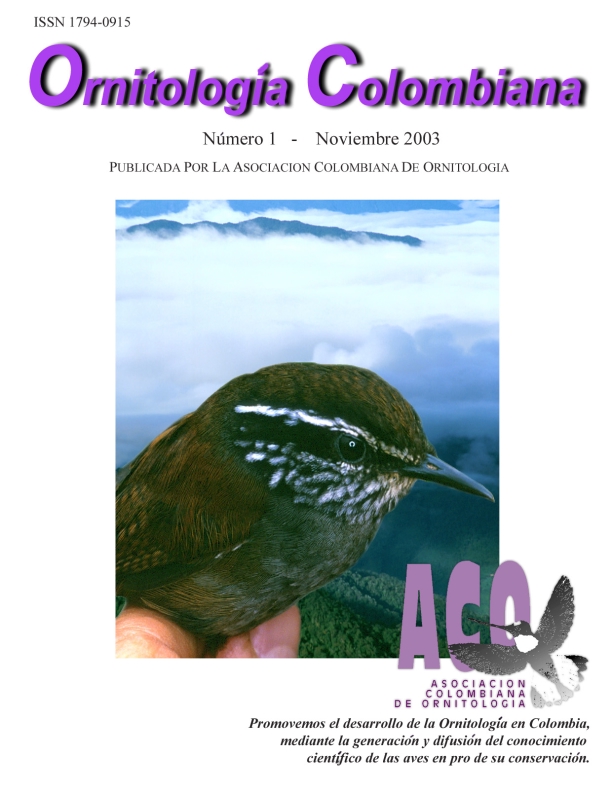Taxonomy of Cistothorus apolinari (Troglodytidae), species concepts and conservation of threatened birds of Colombia: a commentary
Taxonomy of Cistothorus apolinari (Troglodytidae), species concepts and conservation of threatened birds of Colombia: a commentary
DOI:
https://doi.org/10.59517/oc.e23Abstract
No disponible en este tipo de documento
Downloads
References
Avise, J. C. & K. Wollenberg. 1997. Phylogenetics and the origin of species. Proc. Natl. Acad. Sci. USA 96: 94: 7748-7755.
Bates, J. M. 1998. Book review: Handbook of Birds of the World. Vol. 4: Sandgrouse to Cuckoos, edited by J. del Hoyo, A. Elliot, and J. Sargatal. Condor 100: 769-770.
Bowen, B. W. 1999. Preserving genes, species, or ecosystems? Healing the fractured foundations of conservation policy. Molecular Ecology 8 (Supl. 12): S5-S10.
Caycedo, P. & L. M. Renjifo. 2002. Cistothorus apolinari. Págs. 379-382 en: L. M. Renjifo, A. M. Franco-Maya, J. D. Amaya-Espinel, G. H. Kattan & B. López-Lanús (eds.). Libro rojo de aves de Colombia. Serie Libros Rojos de Especies Amenazadas de Colombia. Instituto de Investigación de Recursos Biológicos Alexander von Humboldt y Ministerio del Medio Ambiente, Bogotá.
Cracraft, J. 1989. Speciation and its ontology: the empirical consequences of alternative species concepts for understanding patterns and processes of differentiation. Págs. 28-59 en: D. Otte & J. A. Endler (eds.). Speciation and its consequences. Sinauer Associates, Sunderland, Massachusetts.
Cracraft, J. 1997. Species concepts in systematics and conservation biology - an ornithological viewpoint. Págs. 325-339 en: M. F. Claridge, H. A. Dawah & M. R. Wilson (eds.). Species: the units of biodiversity. Chapman & Hall, Londres.
Cracraft, J. 2002. The seven great questions of systematic biology: an essential foundation for conservation and the sustainable use of biodiversity. Annals of the Missouri Botanical Garden 89: 127-144.
De Queiroz, K. 1999. The general lineage concept of species and the defining properties of the species category. Págs 49-89 en: R. A. Wilson (ed.). Species: new interdisciplinary essays. MIT Press, Cambridge, Mass.
Dobzhansky, T. 1937. Genetics and the origin of species. Columbia University Press, New York.
Haffer, J. 1997. Species concepts and species limits in ornithology. Págs. 11-24 en: J. del Hoyo, A. Elliot & J. Sargatal (eds.). Handbook of Birds of the World, Vol. 4: Sandgrouse to Cuckoos. Lynx Edicions & BirdLife International, Barcelona.
Helbig, A. J., A. G. Knox, D. T. Parkin, G. Sangster & M. Collinson. 2002. Guidelines for assigning species rank. Ibis 144: 518-525.
Isler, M. L., P. R. Isler & B. M. Whitney. 1998. Use of vocalizations to establish species limits in antbirds (Passeriformes:Thamnophilidae). Auk 115: 577-590.
Johnson, N. K., J. V. Remsen Jr. & C. Cicero. 1999. Resolution of the debate over species concepts in ornithology: a new comprehensive biologic species concept. Págs. 1470-1482 en: N. J. Adams & R. H. Slotow (eds.). Proc. 22 Int. Ornithol. Congr., BirdLife South Africa, Johannesburgo.
Joseph, L. 2000. Beginning an end to 63 years of uncertainty: the Neotropical parakeets known as Pyrrhura picta and P. leucotis comprise more than two species. Proceedings of the Academy of Natural Sciences of Philadelphia 150: 279-292.
Joseph, L. & D. Stockwell. 2002. Climatic modeling of the distribution of some Pyrrhura parakeets of northwestern South America with notes on their systematics and special reference to Pyrrhura caeruleiceps Todd, 1947. Ornitologia Neotropical 13: 1-8.
López-Lanús, B. & C. D. Cadena. 2002. Thryothorus nicefori. Págs. 375-378 en: L. M. Renjifo, A. M. Franco-Maya, J. D. Amaya-Espinel, G. H. Kattan & B. López-Lanús (eds.). Libro rojo de aves de Colombia. Serie Libros Rojos de Especies Amenazadas de Colombia. Instituto de Investigación de Recursos Biológicos Alexander von Humboldt & Ministerio del Medio Ambiente, Bogotá.
Mayr, E. 1942. Systematics and the origin of species. Columbia University Press, New York.
Mayr, E. 1963. Animal species and evolution. Harvard University Press, Cambridge, Massachusetts.
Moritz, C. 2002. Strategies to protect biological diversity and the evolutionary processes that sustain it. Systematic Biology 51: 238-254.
Omland, K. E., S. M. Lanyon & S. J. Fritz. 1999. A molecular phylogeny of the New World orioles (Icterus): the importance of dense taxon sampling. Molecular Phylogenetics and Evolution 12: 224-239.
Patten, M. A. & P. Unitt. 2002. Diagnosability versus mean diferences of sage sparrow subspecies. Auk 119: 26-35.
Peterson, A. T. & A. G. Navarro-Sigüenza. 1999. Alternate species concepts as bases for determining priority conservation areas. Conservation Biology 13: 427-431.
Renjifo, L. M., A. M. Franco-Maya, J. D. Amaya-Espinel, G. H. Kattan & B. López-Lanús (eds.). 2002. Libro rojo de aves de Colombia. Serie Libros Rojos de Especies Amenazadas de Colombia. Instituto de Investigación de Recursos Biológicos Alexander von Humboldt & Ministerio del Medio Ambiente, Bogotá.
Rojas, M. 1992. The species problem and conservation: what are we protecting? Conservation Biology 6: 170-178.
Stevens, P. F. 1997. How to interpret botanical classifications suggestions from history. BioScience 47: 243-250.
Stevens, P. F. 2002. Why do we name organisms? Some reminders from the past. Taxon 51: 11-26.
Stiles, F. G. & P. Caycedo. 2002. A new subspecies of Apolinar’s Wren (Cistothorus apolinari, Aves: Troglodytidae), an endangered Colombian endemic. Caldasia 24: 191-199.
Zink, R. M. 2002. The role of mitochondrial DNA studies in elucidating avian subspecies. Resúmenes. Third North American Ornithological Conference, Nueva Orleans, LA.
Zink, R. M., G. F. Barrowclough, J. L. Atwood & R. C. Blackwell-Rago. 2000. Genetics, taxonomy, and conservation of the California gnatcatcher. Conservation Biology 14: 1394-1405.
Zink, R. M. & M. C. Mckitrick. 1995. The debate over species concepts and its implications for ornithology. Auk 112: 701-719.
Downloads
Published
Issue
Section
License

This work is licensed under a Creative Commons Attribution-NonCommercial 4.0 International License.





